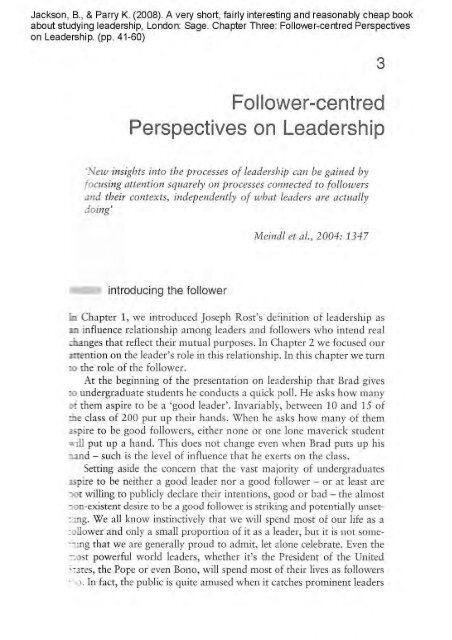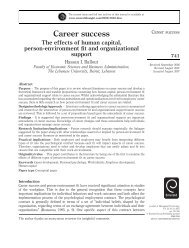Jackson Parry - Leadership, Chp 3, 41-60.pdf
Jackson Parry - Leadership, Chp 3, 41-60.pdf
Jackson Parry - Leadership, Chp 3, 41-60.pdf
- No tags were found...
You also want an ePaper? Increase the reach of your titles
YUMPU automatically turns print PDFs into web optimized ePapers that Google loves.
<strong>Jackson</strong>, B., & <strong>Parry</strong> K. (2008). A very short, fairly interesting and reasonab~ cheap bookabout studying leadership, London: Sage. Chapter Three: Follower-centred Perspectiveson <strong>Leadership</strong>. (pp. <strong>41</strong>-60)Follower-centredPerspectives on <strong>Leadership</strong>3
42 Studying <strong>Leadership</strong>acting as followers, whether it's being cajoled by an adviser or a protesteror being gently reprimanded by their spouse or children. We all have tofollow: as Bob Dylan wryly observes, 'You Gatta Serve Somebody'.Being reticent or reluctant to follow is not something that is peculiarto undergraduate students but, as will see in Chapter 4 on culture andleadership, is a strong feature of individualistically ofiented Westernsocieties, especially those that are characterized by low power distancevalues. Paft of the problem is the word 'follower' itself. Being a followerimplies that you are second best, you are not good enough to lead. Itimplies a measure of servitude, having to become sheep-like or worse -a zombie who is devoid of independent thought, lacking opinion andfree will. For some, the notion of following has strong religious overtonessuggesting blind devotion which further serves to undermine thecurrency of the term.The uneasiness or lack of interest in either talking ahout or understandingfollowership, is reflected in how much less the term crops upon the Internet. Karl Weick notes from a Google search that he found57 items relating to the word 'leader' fo r everyone regarding a 'follower'(Weick, 2007). This imbalance is reflected in the number ofbooks that are published on the subject. While just over 5,000 nonfictionbooks could be ordered through Amazon.com with the word'leadership' in their title, only six books could be ordered w ith the word'followership' in their title. The top three best selling of these wereFollowership: A Practical Guide to Aligning Leaders and Followers,<strong>Leadership</strong> and Followership: The Cybernetics of UniversityGovernance and Political Followership in Nigeria. Before you go onlineto order these - you should note that the latter two are currentlyunavailable. Of course, Ken and Brad have done nothing to correct thisimbalance. But let's face it, if we were to have entitled this book A VeryShort, Fairly lnteresting and Reasonably Cheap Book About StudyingFollowership how many of you would have gone ahead and ei therbought or borrowed this book?One response to the problem has been to look for alternative terms.Various replacements have been proposed from 'team member' to 'collaborator','colleague', 'partner', or even 'peer' - but none of them havecaught on in either popular or academic discourse. The word 'follower'persists, albeit with grudging and somewhat embarrassed acceptance, inour leadership lexicon. We will, however, be using the te rm in thischapter with unbridled enthusiasm as we strive to show that it is notthe act of following that is necessarily problematic, indeed it is vital toleadership, but as with leading there are more and less effective ways inwhich to follow.
Follower-centred Perspectives on <strong>Leadership</strong> 43The undue primacy that is placed on leaders over followers has been::Df"orced by leadership scholars. A major exception to this has been Jim~dl, the Director of the Center fo r <strong>Leadership</strong> Studies at the StateI --:-Iversity of New York, at Buffalo NY Bingh amton, who sadly passed.rwrny at the peak of his career in 2004. jim's major contribution to leader--. sTUdies was to lead a 'follower-centric' approach to leadership studiesoCe:red by way of a much-needed counterweight to an almost exclusive;reoccupation with leader-centric approaches. Consol idating earlier argu= t5 made by Pfeffer (1977), Pfeffer and Salancik (1978) and Calder1977) he observed that, whi le most leadership scholars would have little=lilculty in recognizing that leadership is fundamentally predicated on the~ rionship between leaders and followers, th e follower almost invariably;00.. a minor supporting role in the analysis of leadership.Reading Jim's work, one is struck by his deep-seated discomfort in~e tendency for his peers and his fellow citizens to place sllch greatxock in the role of leaders, especially those at the apex of the organizaeon.This misplaced faith was held despite the overwhelming weight ofm dence showing that external forces and a myriad of alternative interwlfactors are considera bly more influential in determining organi zanalperformance. He concluded with more than a hint of resignation~a [, 'the concept of leadership is a permanently entrenched part of theiOCially constrllcted reality that we bring to bear in our analysis oforganisations. And there is every sign that the obsessions and cdebra::","5 of it will persist' (Meindl, Ehrlich and Dukerich, 1985: 78). The~ enry or so years since he made this observation would have onlyx.fved further to reinforce his convicrioTl .A recendy published book, Follower-Centered Perspectives on:..e.3dership, collects together in a tribute to the memory of James:Meindl a number of researchers who are actively working on the develo?menr of new follower·centric approaches to leadership. In the book's:nrroduction, Boas Shamir provides a helpful overview of this work and:.centifies five roles that followers have traditionally played in leaderi3.iptheories: 'followers as recipients of leader influence'; 'followers as:noderators of leader impact'j 'followers as substitutes for leadership',' :=ollowers as constructors of leadership' and 'followers as leaders'2007). We have used these categories to organize OUf discussion. We"'1. 11 close rhe chapter by considering a sixth role that Boas and his col_!"agues have advocated for foll owers: 'followers as co-producers of7.adership'. This perspective has been developed as a critical alternative:::> ilie five ways in which followers have been traditionally conceptual.: ~d . This is a conceptua lization w hich is very much in tune with our. wn thinking and is ripe for further study and investigation.
44 Studying <strong>Leadership</strong>followers as recipients of leadershipThe passive conception of the follower's role in leadership has been thetraditionally dominant view. As such it has done little to challenge thepopular stereotypes about followers and followership. As we saw inChapter 1, traditional leadership theories posit the leader's traits andbehaviour as the independent variables and the followers' perceptions,attitudes and behaviours to be explained as the dependent variables inthe leadership equation.Even with the more recent theories of transformational, transactionaland charismatic leadership discussed in Chapter 2, the onus isstill firmly placed on the leader to create one or a blend of these formsof leadership for the followers to respond to. If the leader follows thecorrect procedures, he or she will succeed in creating transactional orcharismatic or transformational leadership, irrespective of the followers.The \"lay these theories perceive the leadership process, it does notreally matter who you a re trying to lead. Followers do not play anactive role in the leadership process. It is an essentially linear, one-wayrelationship between leaders and fo11O\vers . The follower is, in effect, ablank slate upon which the leader writes the script.followers as moderators of leadershipAs we saw in the first chapter, contingency theories of leadershipacknowledge that the leader's influence on followers' attitudes and performancedepends on the individual follower's characteristics. T hisview of followers still thinks of them as primarily passive recipients ofinfluence, but acknowledges that the leader's influence may have to bemoderated by the characteristics of the follower.Brad recaUs from the first leadership training course he took, whichwas on 'situational leadership' (Hersey and Blanchard, 1977), that hehad to learn to change his leadership style depending on the level of'maturity' of the follower. This was determined by the ability and themotivation of the follower. With an immature follower, he should takeon a 'telling style' of leadership in which he would tell the employeeswhat needed to be done but not be too interested in them as people.'Relationship behaviour' would come later. As the follower becamemore capable and motivated, Brad could then move to a 'selling style'in which he would keep up the task pressure but could also begin to cultivatea good relationship with the employee.Moving around the compass, he could then progress to a 'participatorystyle' in which he could cease to give direction and allow the
Follower-centred Perspectives on <strong>Leadership</strong> 45iA::Mers to direct themselves and devote his attention to relationships.~I-.. g activities. In the final stage, presumably some form of leadershipaiia2na, Brad could take on a 'delegating leadership sryle' (more deroga~ referred to as 'laissez-faire' leadership), by which he could leave thee::::;.Jioyees to their own devices and let them lead themselves. This all~-ed so enticing in theory, but in practice the followers rarely stuck to;fir SllIlC script. They had obviously been on a different course! They keptd::uv.ing up all kinds of complications such as having different opinions,Cl:I:" sharing the same motives and plunging various spanners into the.a:ks.Contingency theorists have pointed to a number of other aspects ofi:ilo\\'ers that leaders need to take into account when leading. Theseio:::lude: the follower's initia l attitude toward the leader and theira.:Ji:eprance of the leader (Fiedler, 1967); the fo llower's needs for eitheroedmical or emotiona I support (House, 1971 ); and the follower'sb wledge and the congruence of their va lues with their leaders''Yroom and Yetton, 1973) . While each of the theories tri es to point to~othe r aspect of the fo llower that the leader must take into account.nen determining how to behave, the overriding expectation is for the~ der to be the active parmer in the leadership process._111911>followers as substitutes for leadershipFrom time to time the careers section in the newspaper runs articles~ b licizing the latest HR consultancy survey, highlighting the finding:hat the number one reason why most people leave their jobs is because0: a bad boss. Money, conditions, benefits and prospects pale into::lSignificance compared to an abusive or inconsiderate boss it would5et'm. Leaving is, of course, one way to deal with a bad boss. Anotherway is to find ways to avoid hi m or her and minimize the damage.The 'substitutes fo r leadership' theory origi nated by Steven Kerri..Dd John Jermier provides some encouragement in this regard (Kerr,and Jermier, 1978). It argues that, under certai n conditions, the influenceof a leader over a follower may actually be neutralized or even~ bs t i tuted. If it is neutralized, it means tha t it is impossible for either:he task-oriented or the relationship-oriented activities of a leader to::nake a difference to a follower's attitudes or behaviour. If leadership is;ubstituted, it means that the leader's activi ties are not only impossible,::'Iut they arc also largely unnecessa ry.Returning to the problem of avoiding a bad boss, those followers·.,·ho have high levels of ability, experience, training and knowledge -::.5 well as a high need fo r independence and a strongly ' professional'
46 Studying <strong>Leadership</strong>orientation - tend to have a low need for both the relationship-buildingand task-oriented activities of the leader. Moreover, when the task athand is relatively straightforward and routine you have linle need for aboss. Alternatively, if you can get into a job that is intrinsically satisfying(such as being a university lecturer perhaps? ), or yo u can see directlywhat you have achieved such as when you are a paramedic, you do notneed a boss to explain to you how important your work is or how youare doing. Finally, you might consider joining an organization which ishighly bureaucratic in that the work and the rewards are highly formalizedand little is left to the boss's discretion. Best of all, try taking a jobin which there is considerable spatial distance between you and yourboss, but beware of the remarkable reach of the Blackberry.Perhaps not surprisingly, the substitutes for leadership theory hasstrong intuitive appeal for those who do not subscribe to the importanceof leadership in organizational processes. It serves quite effectively totake the wind out of the sails of leadership scholars who trumpet thecentral importance of leadership in organizational success and failure. Ithas, however, failed to lead to much in the way of subsequent research,serving primarily as an act of protest. A series of exchanges published in<strong>Leadership</strong> Quarterly may, however, succeed in generating further theoreticaland methodological refinements to the substirutes for leadership,particularly as it applies to strategic leadership at senior levelswithin organizations (Dionne, Yammarino, Howell and Villa, 2005).Boas Shamir characterizes the way in which the substitutes for leadershiptheory perceives of the follower's role as an extreme version ofseeing followers as moderators of leadership. ]n common with this perspective,the specific activities of followers in substituting for leadershipare uot actively theorized. The theory has been developed primarily tode-emphasize the significance of the leader but it does not do a lot toexplicate the role of followers in creating leadership. As we shall see inthe following section, the next group of theories have made this tasktheir central concern.followers as constructors of leadershipIn this section we will talk about research that has examined the way inwhich followers make or construct leadersh ip. These researchers arepreoccupied with the thoughts of followers, most especially how theyconstruct and represent leaders in theic thought systems. They make thefundamental point that leadership is essentially in the eye of the follower.Unless followers recognize it as leadership, it isn't leadership. Wewill distinguish between three groups of theories that have identified adifferent aspect of this construction process: the romance of leadership
Follower·centred Perspectives on <strong>Leadership</strong> 47iIkory, the psychodynamic theory of leadership, and the socia l identityDeory of leadership._the romance of leadership& the beginning of this chapter we noted that the follower·centric viewof leadership emanated from a concern that most leadership scholars&aad. become overly preoccupied with the role of the leader in creatingleadershi p, whi le virtuall y ignori ng the role of the followe r. Essentially,leadership scholars were mirroring and indeed perpetuating, the hypeiI:l'CI unrealistic expectations rh at are routinely placed on leaders in a llspberes of huma n endeavour, bur most especially in the world of bus iiiItSS and politics. Rather tha n turn their back on leadership studies, Jim}'leindl and his colleagues decided to make this tendency to overestii:Jatethe significance of leadership their central concern .At the heart of their analysis lies the notion of the 'romance of lead·~ ip ', which they suggest 'denotes a strong belief - a faith - in theportance of leadership factors to the fu nctioni ng and dysfullctioningorgan ised systems' (Meindl and Ehrl ich, 1987: 91). A series of empiricalstudies conducted in la boratory settings - through the developmentof a survey instrument, the Romance of <strong>Leadership</strong> Scale (RLS ) - andthe analyses of media reports revealed a consistent pattern of fo llowerbehaviour (Meindl and Ehrlich, 1988). In the absence of direct, unambiguousinformation about an organization, respondents would tend to£SCri be control and responsibility to leaders with events and outcomesro which they could be plausibly linked (Meindl et al. 1985). In effect,b dership acted as a simplified, biased and attractive way to make~e of organ izational performance. Moreo' ef, this romantic tendency~ med to have the greatest sway in extreme cases - when things we re50mg either extremely well or extremely badly observers tended to lay:he credit or blame at the foot of the leader.Meindl did not advance the fo llower-ccmric approach in an effort!!ther to compete or to replace the dominant leader-centric approach .. -\5 Meindl noted: 'Rather than being anri·leadership, the romance of~ ders hip , and the perspective it provides, is more
48 Studying <strong>Leadership</strong>Manchester United players would do everything they could to keep SirAlex Ferguson in his winning ways.Meindl described the romance of leadership as a social construction.Followers construct their opinion about the leader by interacting withother followers. Cemr::d to th is process is something he called social contagion,which he described as 'a phenomenon of the spontaneous spreadof affective and/or behavioural reactions among the members of a groupor social collective' (Meindl, 1993: 101 ). As its name suggests, we canthink of a leader's reputation (good or bad) as being something akin toinfluenza that can be passed on from follower to follower until everyonebecomes infected. Social contagion highlights the interpersonal processesand group dyna mics that underpin the widespread dissemi natio n ofcharismatic effects among fo llowers and subordinates.The media are important contributors to these social constructionand socia l contagion processes. Media accounts influence and shape theattributions that followers might give to a particu lar leader. They canalso shape our general beliefs about what constitutes effective and ineffective,ethical and unethica l leadership. These processes are illustratedto good effect in an empirical study, based 0 11 medi a accounts, conductedby Chen and Meindl (1991) of the ca reer of People Expressfounder and chief executive Dona ld Burr. Burr's ai rline enjoyed a briefbut highly celebrated heyday before encountering insmmollntablefinancial problems and folding into Texas Air just five short years afterit made its ina ugmal flight in 1981 in a blaze of publicity. The studyshows how the press collectively constructed Donald Burr as an idealizedrepresentation of the American entrepreneurial spirit, infused withvision and inspiration in the manner of a pioneering evangelicalpreacher. They stllck with this image of the leader throughout the lifeof the company but made a marked switch - in the face of sustainedpoor company performance - fro m celebrating the positive connota·tions associated with this image to revealing its negarive connotations.Chen and Meindl conclude that, comrary to popula r wisdom,leaders do nOt control their own destiny despite rhe best efforrs of publicrelations professionals. Brad knows this only too well from his time as a'spin doctor'. The identity and influence of leaders depends to a largeextent on the manner in which thei r fo llowers perceive them. Both leader ~and followers arc subject to a range of forces beyond their direct control:prominent among rhem
Follower·centred Perspectives on leadership 49.:bnonal or strucrural forces . In constructing leader images, they march... leader's characteristics with the performance of the finn.Consequently, the CEO of a successhtl firm will rend to be depicted withpmaive personal qualities, and vice versa.The 'celebrity CEO' phenomenon takes full advanrage of ourw:odencies to rornanricize leadership. In an increasingly complicated and.-personal world, the public face of a charismatic and appealing CEOc:an prove to be a highly effective means for a company to build a sym·WK link or brand with its various stakeholders, such as irs sharchold·ers.. its customers or its suppliers. A 'real' person provides the humanmuch that c:mnot be provided by a me re logo. It is almost impossible to.. think about Richard Branson without thinking about the VirginIsnnd and vice versa. Having a celebrity CEO at the helm can act as adouble·edged sword, however. It is difficul t to maintain confidence in an~ nizat i o n once the influential founde r moves on, as The Body Shopiound when Anita Roddick gave up control of the company. It's evenIIIOre of a challenge when your founder goes to jai l, as was demonstratedWl spectacular fashion with the imprisonment of Martha Stewart.~ emption can be a powerful morivaror as witnessed by the impressivemmaround in Martha Stewart Living Omnimedia, Inc. since he r release.The romance of leadership theory is particula rl y strong indesc ri bi ng a tendency for fo llowers to exaggerate rhe importance andmil uence of the leader in determining a group or organization's per·lOnnance. If things are going well, it's the leader's doing; if things are~mg badly, that is also the leader's doing. The theory also providessome useful insights into how this takes place, with its exposition of~ al construction and social contagion processes. \Vhere the theory ISDOt as strong is in explaining why this happens. The follow ing two theones- psychoana lytic theory and social identi ty theory - provide pointersas to why followe rs might choose to construCt leadershi p in the way:hey have bee n observed to do.pyschoanalylic theoriesunen we addrc!
50 Studying <strong>Leadership</strong>influenced by the models of leadership exh ibi ted by parents, teachers,coaches and other adults during the matmacion process from child,through adolescent, ro adulthood. Most potent of these is the style ofparenting, particularly very early in the impressionable yea rs (Keller,2003). An adu lt might choose ro copy that parent's style or may choosea diametrically opposite style. We often see someone who was raised inan authoritarian way consciously reject this approach in fa vo ur of amore laissez-faire approach. One is, however, struck when confrontedwith the actual challenge of raising a child, how those familiar patternsemerge - despite our best intentions.The way in which we are raised also influences the way in which wechoose to follow. If adults find themselves in a relationship with either anauthoritarian leader or a leader \vith a more parricipative style, rhe reactionof the adult may be influenced by rhe way their authority figures,parents in parricular. behaved and dealt with authority figures in the past.Psychodynamically, we may react to a leader in either a dependenr, acowlter-dependenr or an independent manner (Stech, 2004). We mightbecome totally dependent on the leader for our livelihood and our emotionalsupport. When we react in a counter-dependent way we reactrebelliously, rejecting the directives of the leader. As an independent fo llower we look at the leader's directive objectively, assessing whether ornot it is reasonable and ethical, before choosing to act. It is this type offollowership behaviour that responsible leaders actively try to encouragein their followers. Dealing with chronically dependent and counterdependentfollowers presents two different setS of challenges that canprove to be grue lling and very painful to address for both parties.In explaining why fo llowers construct leaders in a dependent way,psychoanalytic theories of leadership point to two psychodynamicprocesses: projection and transference (Shami r, 2007). Projection is theprocess by which we attribute to another person our ideals, wishes,desires and fantasies. We see this tendency being demonstrated bydiehard fans of pop stars, actors and models. Transference, on the otherhand, is the process of responding to another person as if that person wasone's mother, father or another significant person from early ch ildhood.Pyschoanal ytic theories suggest that these processes are particula rl ys
Follower-centred Perspectives on <strong>Leadership</strong>5 I~} who ruled despotically over primitive human societies. Taking.. Darwin's notion of the 'primal horde', Freud argued that the father_ chief was a strong and independent figure who imposed his wil! on• cxber members of the group. Followers had the ill usion that theirD!er loved each of them equally.Leaders can also provide a means by which the follower can reduce"*" level of anxiety and provide them with a measure of psychologisafety.In order to meet these pyschological needs followers, through* processes of transfe rence or projection, will sometimes knowingly.-...rate ~ sometimes prefer and evell create - 'toxic leaders'. JeanJ..t:man-Blu men notes that 'toxic leaders manipulate their foll owers'..cma ry human needs and exploit their existential circumstances. They_ this by creating illusions designed to allay the fears and address thean condition to which we all are heir' (2007: 3) . By the same token,L~ Offerman (2004) alerrs us to the v;1riOIlS ways in which 'toxic fol __ ~ rs ' might similarly lead their leaders astray.Cult leaders such as Charles Manson, Jim Jones and David KoreshJIR held up as i_nfamous prime exemplars of this form of deleteriousbdership which Micha Popper likens to a process of mass hypnosis inwtuch followers lose their self and the ability to reason autonomously4Popper, 2001). We ca n also see elements of this process in more conw:nrionalleader~fo\l owc r relationships. Brad's doctoral research, forcurnple, examined why so many managers chose to follow such mam~ en t gurus as Stephen Covey, Michael Hammer and Petcr Senge.The psychodynamic approach to Icadershi p is by no means a~ S tream approach within the study of leadership. <strong>Leadership</strong> schol.ars share the same genera l discomfort and reticence about working with!be unconscious mind that psychologists tend to have. Critics point to6e approach's origins in the clinical observation and treatment of~ ple with serious difficulties, not those whom we tend to find in typ...::a1 workplaces. The theory is also based on the subjective findings of.:hnical psychologists collected from individual case studics; it is not:-..sed on conventional scientific principles. In defence, Manfred Kets de'; nes observes with typical irooy, 'it's something of a paradox that,...---TIde at a conscious Icvel we might deny the presence of unconscious~ocesses , at the level of behaviour and action \-ve live out such processes,",,,yday a ll over rhe world' (2006, 4).On the positive side of the ledger, psychodynamic theory does:- ":ourage an analysis of the affective relationship between the leader~ -.J fo llower. It encourages us to look to our past to identify deeply- i:~ai n ed and recurrent patterns that might undermine ou r ability to": .:ome a fu lly effective and responsible leader and follower. It also asks-: Jwkward questions about leadership that might provoke discomfort
52 Studying <strong>Leadership</strong>but nonetheless should nor be left unasked. Goethals (2005) approvinglynotes that it dares to suggest that perhaps people have a fundamentalinstinct to follow that is bolstered by a deep-seated 'thirst forobedience'. Perhaps these are fundamental drivers for leadership and,as such, deserve further enquiry.social identity theory of leadershipThe third and final theory which emphasizes the process by \vhich followersconstruct leaders is called the social identity theory of leadership.it proposes that the extent to which a leader is either selected oraccepted by a particular group will depend on how 'prototypical' (i.e.representative) she or he is to that group (van Knippenberg and Hogg,2003). Hogg defiues proto typicality as 'a fuzzy set of features that capturesingroup similarities and intergroup differences regarding beliefs,attitudes, behaviours and feelings' (2005: 56).It draws upon the popular saying that 'like attracts like'. However,instead of the leader being attracted to a follower who shares a similarbackground and beliefs, and consequently brings a follower into his orher group, social identity theory highlighrs rhe reverse process throughwhich the leader is picked by followers or is chosen to be supported byfollowers precisely because he or she is most like them. When we talkabout 'like' here, we mean how closely the leader represents the group'scharacteristics as well as its aspirations, values and norms.Prototypicality is not the only basis for leadership, however. Peoplealso rely on general and more task-specific schemas or stereotypes ofleadership behaviours which have been dubbed by Robert Lord and hiscolleagues as 'leader categories' or 'leader schemas' (Lord, 1985). These\-vill be become particularly significant when we move our discussion onto the influence of culture on leadership in Chapter 4.The importance of these stereotypes we hold about appropriate andinappropriate behaviour diminishes as group prototypicality becomesmorc important. That is, group membership becomes psychologicallymore salient. A group is psychologically salient if being part of it isimportant for someone as a basis for defining who they are, what theybelieve in, and how they function as an individual. This could be a gang.an Imefllet discussioll group, a spons [cam, a [an club or a service club.While you might have a general view of what constitutes good or badleadership, you will put up with leadership behaviour that is at oddswith your ideals if belonging to the group is very important to you.The way social identity theory is set up, the study of leadersh ipbegins with the group and not the leader. Assume you are observing agroup of people, how does that group go about selecting and supportin.l'
Follower-centred Perspectives on <strong>Leadership</strong>S3appropriate leader - nominal or otherwise? Social identity theoristslii1!'8est that this takes place III three broad phases (Hogg, 2005). First, a~ p member who is the most prototypical will appear to exercise influmerover other group members. Second, because the most prototypicalDmlber is consensually liked by the group members (i.e. he or she islIy attractive), this will empower that person i:lJld enable him or hermfIuence other members. Eventually, that person will begin to bem.nued with prestige and status. In the final phase of the process, group~ bers begin to attribute the success of their leader to that person's spea.aJpersonality and not because of their prototypicality. In this way ac::.nismatic personality of the leader is constructed (Shamir, 2007).By the same token, when the leader begins to fail to fully representIIi:lt' group, to 'sell out' to other interests, followers might decide that- is due to personality defects of the leader. Consequently, they maydt\.-ide to withdraw theif support. In politics this is often the f3te of, pulist leaders who come to power as a resu lt of grassroots moveIiZTlts but, without the suppOrt of a political machine, lose the support• meir original followers as they attempt to build a broader coalition: su pport wi th other groups in order to stand a chance of gaining orsulOta ini ng wider power. The spurned in-group may respond by select-0' a leader who is more prototypical.Social identity theory has been empirically tested in borh laboratory.md naturalistic field settings. For example, one laboratory study askedmxients to anticipate joining a group in order to discuss university::-esoUfce allocation for undergraduate classes (Hogg et aI., 200'1). Thesalience of belonging to a particular group was manipulated in such a way.IS to make membershIp seem more or less important to the students.flarricipants were informed that their group was to have either an 'agen::LI'msrrumental' (i.e. male stereotypical) norm or a 'communal/expressive'l1. fema le stereotypical) norm for how the disclIss ion was to be co n ~:xred within theif groups. Participants were also £old that a leader had~n randomly appointed - they discovered that the leader was either a=-.tIe or fema le. The study found that group salience would increase the~ceived effectiveness of ma le leaders for those groups who had beenlS.5Jgned an agenridinstrumental norm and female leaders of groups with.: .:ommunaVexpressive norm. It would also reduce the perceived effective-("55 of male leaders of groups with communaVexpressive norms and"='l1ale leaders of groups with agenriclinstrlllllcntal norms. In other words,-:e study found rhat when dealing with matters that count, leadership:- Cl.-rivcncss depends more heavily on the match of the leader to the group;')totype.Social identity theory can be helpful in making sense of a number of-.remporary leadership issues. For example, resea rch has shown that\'\'estern societies, demographic minorities {e.g. women and ethnic
54 Studying <strong>Leadership</strong>minorities women ) can find it difficult to attain top leadership positionsbecause of what is widely described as a 'glass ceiling' (Stafsudd, 2004).If organiza tional prototypes (e.g. of speech, dress, attitude, interactionstyles) are societally cast so that minorities do not match them well,then minorities are unlikely to be endorsed as leaders under conditionswhen organizational prototypicality is more important - that is whenorganizational identification and cohesion are high. This might ariseunder conditions of uncertainty such as when a company is underthreat from a competitor or a potential takeover. This is an unfortunatetendency for a number of reasons, not least because it is often the casethat, when a company is in most in need of change, an outsider's perspective is what is most needed to lead the company out of its difficulties.lowards a general modelEach of these three follower-centric theories - the romance of leadership,psychoanalytic and social identity theories - provides a usefulinsight into the process by which followers construct leadership. BoasShamir suggests that if they are intertwined ,ve can begin to develop ageneral model of the construction of leadership by fo llowers. Beginningwith the individ ual, drawing on a number of motiva tional theories, weneed to understand that the follower has severa l unmet needs which apotential leader ma yor may not be able to fulfil. These are the need forclarity (c.g. what should we be doing? where are we going?), the needfor meaning (e.g. what are we doing this fo r?) and the need fo r safety(e.g. will we be OK if we do thIS?).Leaders are constructed in light of these unmet needs at the level of theindividua l and at the social level. Individuals construct leaders through theprocesses of attribution (e.g. they believe they are responsible for causingcertain th ings); projection (e.g. attributing our ideals, wishes and desires tothe leader), transference (e.g. responding to a leader as if they were asignificant person fro m childhood) and idealization (e.g. they can do nowrong). At the societa l level leaders are constructed through the twi nprocesses of social information processing and social contagion.Based on these constructions leaders are selected, supported andtheir infl uence is accepted. This is by no means ;] static process.CunsrrlH.:tiuH is work lhat is always in progress. Leaders arc constantlybeing assessed and compared to other leaders, real or imagined.Likewise, as Mary Uhl-Bien and Rajnandini Pillai (2007) have intri g ll ~ingly argued, followers and leaders also construct notions of foll ower ~ship. Fo llowers either reinforce or refine their constructions as newinformation comes to light, via direct or indirect interaction, either with
Follower-centred Perspectives on <strong>Leadership</strong>5SF_ser.es or influential others who reporr on these interactions.Ii- ......-.-:==nes, when leaders are seen to fail in a major way, fo llowerst '" e so disenchanted and angry that they arc forced to demolish.:onsrructions and seek an alternative leader. Because most of these---" iM JeS ha ve been preoccupied with explicating how leaders are cre~ me processes by which leaders are deconstructed, or if you like~-ea [ e d ' , are relativel}· unexplored.Follower-centric theories have sought to turn a lot of the conven=e=ral leade r-centric research that was discussed in Chapter 2 on its"..,.-i They have shown that there is indeed much to be gained by start~ our study of leadership with the fo llower and not the leader. In this~-d they have provided a much-needed correction and counterbal~ \0 the dominant preoccupations of leadership schola rs. In fact we~ t even go so fa r as to ask, given the influence that foll owers can:::en over leaders, why we might not consider the possibility of fo llow~ acring as leaders. Indeed why not get rid of the leader-follower~wm )'altogether? Tt is to this possibility that we now briefly turn.followers as leaders: shared leadershipapproach is techn ica lly neither leader-centred nor fo llower-centredX'O,use it rejects the distinction between leaders and fo llowe rs.~rs h i p is seen not as a role, but as a function or an activity that can.Jtared among members of a group or organization. Fundamentally, at"3C' core of this approach is a belief that followers can and should be given=-or chance ro lead, as it is not only the right thing to do but also theiC.l.11'est thing to do. Traditional command-and-control, hierarchically~ organizations arc seen as being no match fo r the flat, brerally-.rgratcd network organizations in the cOntext of a ra pidly changing_ ""TIpetitive global economy.~.,1e can think of the va rious theories which advocate that followers"';"'Quld act as leaders along a continuum. At the more conservative end of~ continuum is the notion of 'co-leadership', which recognizes that lead=-Jup is rarely the preserve of one individual but frequenrly is exercised by.: :"'J.lr of individua ls, a 'Number One'J
S6Studying <strong>Leadership</strong>a certain period, during a key phase in a project, and then leadership canbe passed on to someone else. For example, Joseph Raelin (2003) in hisbook, Creating Leaderful Organizations, argues with infcctiolls passionthat 'in the twenty-first century organization, we need to establish communitieswhere everyone shares the experience of serving as a leader, notsequentially, but concurrently and collectively' (2003: xi). The principaltask of senior management in th is kind of organiza tional mi lieu is toproduce the environment and the climate where followers can feel genuinelyempowered to lead within and beyond the organization.Even further along the continuum is the notion of 'distributed leadership'in which the team leads its work collectively by creati ng norms ofbehaviour, contribution and performance, and by supporting each otherand maintaining the morale of the group (Day, Gronn and Salas, 2004;Gronll, 2002). This perspective complements, but docs not replace, t h~perspective of leadership as an input to team processes and performance.However, a singularly zealous advocate of this approach Jeffrey Nielsen,in his book The Myth of <strong>Leadership</strong>, 'makes the case for the end of leadershipas we commonly know it - that is, rank-based management - andintroduces a method for developing an organization into a true society ofpeers. I call this model the peer-based organization' (2004: x).These theories tend to be more normative rather than descriptive.They talk about how things should be rather than how the)' necessarilyare. However, case studies of exemplary pracrice arc enthusiasticallypresented from companies as di verse as law firms, car manufacturersand IT service providers as evidence that shared and dispersed leadershipare more than a gleam in the organizational theorist's eye. Though stilla rarit)" these forms of leadership do exist and can succeed .At the morc radical end of the continuum is the notion that the te rmleadership might be profitably dropped as a useful means of under·standing organizational behaviour. Alvesson and Sveningsson (2003).for exa mple, have shown th rough their empirical study of a researchand development company that although senior and middle managersused the term 'leadership' freel), to describe all manner of activities tharwere raking place within their organization, when pressed to expancupon and explai n how leadership actually works, they were ge ncra ll ~at a loss to do so. Tn light of this finding, and the general concerns t h e ~have about the inconsistency of definitions of leadersh ip coupled witl·our tendency to romanticize leadership, rhe aUThors concluJeJ that per·haps we should seriously question the existence of leadership and, b:,association, followership as a distinct phenomenon. Instead we migh·probably be better to think of leadership as a hypothetical construethat has no empirical reality.Because notions of shared and distributed leadership are attractil'_so much interest among leadership and organizational scholars as W L
Follower-centred Perspectives on <strong>Leadership</strong> 57Zi practi tIOners and consultants, we wi ll devote an entire chapter.Gapter 5) to the topic. In that chapter we will also pick up on and~nd upon the critically-oriented post-structuralist approaches tobdership that question many of the fundamental assumptions thati:adership researchers have made about the existence of leadership as a..::srinCt phenomenon. For now we want to close this chapter with an.ippfoach rhat recognizes the contributions of the follower-centric theories.:2scussed above and seeks to integrate these with considerations of the:ole of the leader in constructing leadership. Indeed it sees leadership asiOIllething that is essentially co-produced by followers and leaders.followers as co-producers of leadershipThe idea that leadersh ip is a relationship based on a mutual exchangeterween leaders and followers is not new. Hollander (1958) for example,suggested that leadership is a rwo-way influence and social exchange relarionshipbetween leaders and fo llowers. Messick (2005) describes leadershipas
58 Studying <strong>Leadership</strong>strengthen the leadership relationship in the knowledge that this wasvital to the survival of the group (Shackleton, 1999).The best effort to date to model the co-production of leadership in adynamic way is Leader-Member Exchange (LMX) theory which, basedon repeated empirical observation, argues that leader-follower relationshipsevolve through three distinct phases (Graen and Uhl-Bien, 1995).At the initial 'stranger phase', interactions are largely formal, rule-boundand driven by ~elf- interes t rather than the good of the group. Some relationshipsnever evolve from this stage. However, others may progress toa second phase, the 'acquaintance' phase - a testing phase in which theleader gives the follower the opportunity to take on more responsibilityin return for inside information , and friendship and support. Assumingboth the leader and the follower pass the test, the relationship becomesbased more on mutual trust and respect and less on formal contractualobligations. Ar the final 'mature' phase, there is a high degree of reciprocitybetween leaders and followers; each affects and is affected by theother. Leaders and followers become tied together in productive waysthat go well beyond the traditional hierarchically defined work relationshiptowards a transformational leadership relationship.LMX theory is intuitively appealing. It accords with the experienceswe have had both as follower and as leader. It brings into relief the factthat differences exist in the quality of relationships that leaders have withindividual followers. There are times we have really got on with a bossand there are times when we haven't, and yet others seem to get onfamously with that boss. It also issues a cautionary note in warning leadersof the dangers of being selective in whom they choose to favour as thisfosters divisive in-groups and out-groups within the la rge r group. Leadersare, therefore, encouraged to cultivate high-quality exchanges with all oftheir follo\vers, recognizing that ultimately it always 'takes two to tango'.Keith Grint has noted that leaders can learn a lot about how to leadfrom their followers. He draws an intriguing para llel between the challengeof learning how to lead for the first time and the challenge orlearning how ro become a good parent, noting that 'in both cases, anecounter-intuitively, it is the junior that teach their superordinates howto lead' (2005: 104). In order to do this, open, honest and continua:feedback is essential. Looking back on how we le:1rneri to hecome p:1r·ents we probably should have devoted more time and effo rt to trying rclearn from our children instead of relying on more traditional source- such as our parents, our friends or child-rearing books.The parent--child metaphor, especially in light of our discussion (- .psychoanalytic theories of leadership, is potentially fraught with corr·plications - not least because of its implicitly paternalistic or matern ,::istic view of leadership which all leadership scholars worth their sal t ~',trying to rid the world of. However, we think it's helpful here beel!-'
Foll ower-centred Perspectives on <strong>Leadership</strong> 59addresses the joint responsibility that leaders and followers have to,::~up lines of comm unication with each other. We need to create• - \-,ship relationsh ips that are based on 'constructive dissent' rather~ 'destructive consent' (Bratton, Grint and Nelson, 2004 ). This is a.ImoDship in which follO\\'ers are wi ll ing and capable of questioningsuggesting alternative courses of action in a way that does not'hlu ine or persona ll y attack the leader, and leaders are open and.. x ... ely supportive of such efforts.The movie, The Queen, provides a striking example of a highlyadbaated moment when the roles between leader and fo llowers wereasused. It is a fictional depiction of the behind-the-scenes turmoil withinRoyal Family in the aftermath of Princess Diana's death. The Queen• stOically determined to fo tlow protocol and to mourn the death pri~ and not bow to her subjects' desire, fanned by the media, for her to~ Iy acknowledge the death. In the end the Queen acquiesces makinga public statement via television and by ordering the Royal Ensign to be..-n at half-mast above Buckingham Palace. In dramatically compellingbs!uon, we witness a liminal moment in which the fo llowers are seen tolead the leader. A sub-plot in the film is, of course, the newly-elected TonyIbrr·s role in infl uencing the Queen to change her stance in the interestsei preserving the monarchy's leadership in rhe longe r term. One, ofQ1lll"Se, can't help musing at the end of the film \ .... hether Tony Blair himiidimay have lost sight of the principle of fo llower-led leadership whenk made the decision to take the United Ki ngdom into the \Var in Iraq.Perhaps Tony Blair and other besieged leaders might de rive some form.. comfort from the lessons that Ke ith Grint distils in his book, The Arts.{ <strong>Leadership</strong>. On the surface, this book appears to be yet another COI1 --=nrional celebration of the heroic pursuits of well-known historical figeessuch as Horatio Nelson and Florence Nightingale, as well as business!taders Fredd ie Lakef and Rjchard Branson. From these accounts, Grint~vi des evidence not of theif cumu lative successes but of the propensity,.,ogularly and rominely to fail and make mistakes. What distinguishes::.!m from leaders whom we have long since forgotten is the prepollderoceof their fo llowers [Q consistentl y support and cover lip for them . He;'Olgnan tly concludes, 'the trick of the leader is [Q develop followers who;nvately resolve the problems leaders have caused or cannot resolve, but:\lblicly deny their intervention ' (2001: 420).To date we have developed a reasonably robust understanding of the':"':.£ferent types of leader, but we still tend to treat fo llowers as a homo~~n eo u s entity. Collinson (2006) has noted that studies of leadership- ~ d to develop a broader and deeper understanding of fo llowers' iden-- ::es and the complex ways in which these selves may interact with those- leaders. His post-stru cturalist approach to study ing leadership high-.::us that followers' identities may be more differentiated and contested
60 Studying Lead ershipwithin the workplace tha n is generally assumed. Coll inson's ownempirical research has shown that leaders are ohen surprised by theunanticipated way fo llowers react to their plans (Collinson, 2005 ).Followers are smarter and more cunning than they tend to be givencredit for, whether it is in the way they appear to support, confo rm orresIst.There is a well-worn saying that 'we get the leaders we deserve'. Thisis a statement that infuriates many of those we lecture to as it runs counterto the prevailing leader-centric wisdom. We believe, however, there ismuch to be said fO f this statement as it encourages everybody to take aninterest in, and play an acti ve role in produci ng the highest fOfm of leadershipwe can. The follower-centred perspecti ves of leadership are hel pfulin this regard because, as Shamir notes, they enable us to 'reverse the lens'of leadership; they encourage us as followers to nOt only look at leadersbut also at ourselves and others as followers. In reversing rhe lens, however,'it is important to examine nor only how folJowers contri bute to theconstruction of a leade rs hip relario nship, but also how they empower theleader and infl uence his or her behaviour and what is theif contribution todetermining the consequence of the leadershi p relationship' (2007: xxi).conclusionIn this chapter we surveyed wide-ranging work done by those who hH ebeen curious about that other generally unheralded group of peopl:when it comes to leadership, nameiy the followe rs. \YJe looked at varoustheories that have conceptualized followers to varying levels c:significance, either as moderators or constructors, substitutes, or CC'producers of leadership. This work has sought to provide a mu.:needed coumerbalance to the predominant lopsided focus on leade:held not only by academics bur by the genera l populace. We bel ieve t h~·this work creates a more holistic and complete picture of how l ead c~ship works or fails. Given its youthful and partially formed nature, fclower-centred perspectives also provide plenty of scope for produc: :- .fresh and exciting new research. Finally, and most importantly.encourages u) to reflect and actively think abour what we might char _in our much rehearsed role as followers to co-create better and h ig ~forms of leadership.
















